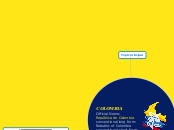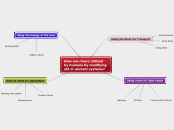THANK'S
COLOMBIA
Official Name:
República de Colombia
conventional long form:
Rebublic of Colombia
conventional short form:
Colombia
TYPICAL SYMBOLS OF COLOMBIA
National Drink: Coffee
National Dish: Bandeja Paisa
National Hat: Sombrero Vueltiao
National Jewel: Emerald
National Horse: Paso Fino
National Sport: Tejo
National Tree: Wax Palm
National Flower: Orchid (Cattleya Trianae)
National Bird: Andean condor
TOURISTIC PLACES
GOVERNMENT
Form of Government: Unitary republic
Chief of State and Head of Government: President; elected to four-year terms.
Current Presidente: JUAN MANUEL SANTOS elected on August 7, 2010
Legislature: Congress; consists of Senate and House of Representatives; members elected
to four-year terms.
The legal voting age: 18 years
THE CAPITAL CITY
Bogotá is the capital and largest city in Colombia. A melting pot of people from around the country, it is diverse and multicultural, with a blend of modern and colonial architecture. The predominant colors in Bogotá are the green of the city’s many parks and the eastern mountains overlooking the sanctuaries of Monserrate and Guadalupe, and the rich red of its many brick buildings.
ECONOMY
Main Agricultural Products: Coffee, corn, rice, potatoes, fruits y flowers, sugarcane.
Main Mined Products: Emeralds, coal, petroleum (oil), natural gas, gold, iron ore.
Main Manufactured Products: Textiles, foods, chemicals, machinery, electrical devices,
transport equipment, metal products.
Main Exports: Coffee, oil and petroleum products, fruits, flowers, iron and steel,
textile and devices, cotton, leather.
Main Imports: Machinery, chemicals, transport equipment, etc.
Monetary unit: Peso ($COL)
Colombia is a rich country, both in terms of its history and the sheer number of products it produces on a global scale, including coffee, flowers, gold, emeralds and crafts. Some Colombian exports have become so famous they have converted into national symbols, alongside the Colombian flag, anthem and coat of arms. They now unite Colombian people and allow them to take pride in their country of birth wherever they may travel.
NATIONAL SYMBOLS
THE NATIONAL ANTHEM
THE NATIONAL ANTHEM OF COLOMBIA was officially adopted (Law 33) in 1920. The lyrics of the anthem were written by Rafael Núñez and the music was composed by the Italian composer, Oreste Sindici.
On November 11, 887 the anthem was sung in public for the first time. On December 6, 1887, its first official appearance took place at the Graduation Hall in front of the Palace of San Carlos in the presence of Rafael Núñez, military, ecclesiastical and civil authorities, ministers and members of the Diplomatic Corps. It was sung by a 25-voice choir, accompanied by an orchestra conducted by Maestro Oreste Sindici. It was adopted as the National Anthem by an Act of Congress in 1920.
COAT OF ARMS
The Coat of Arms was introduced on May 9th,1834.
The coat of arms is in the shape of a shield (Swiss form) and is 6 parts wide by 8 parts high. It is divided into three distinct horizontal sections.
The upper section, on a blue field, has in its centre an open gold pomegranate with red grains inside, a golden stem and leaves.
On each side of the pomegranate there is a recumbent golden cornucopia, the one on the left pouring coins toward the pomegranate, and the one on the right full of tropical fruits.
The pomegranate (granada) denotes the name of the country at the time the coat of arms was introduced (La Nueva Granada) and the cornucopias symbolize the wealth of the land, its minerals and the rich soils of the tropical zone.
The middle section shows a Phrygian cap (the symbol of freedom) on a platinum field (a Colombian precious metal).
The lower section shows the Panamanian Isthmus separating the two adjacent silver seas, with a black ship, sails unfurled, on each of them. The Isthmus no longer belongs to Colombia.
The condor, representing freedom, perches at the top of the coat of arms. Hanging from its beak is a laurel wreath, intertwined with a golden waved ribbon tied to the emblem. The words "Libertad y Orden" (Freedom and Order) are written in black on the ribbon.
Four tilted lances rise from the sides of the coat of arms, two on the right and two on the left, from which hang four Colombian flags which surround the emblem. The flags are bound together at the bottom tip of the shield.
FLAG
The national flag consists of three horizontal stripes; the yellow upper stripe is twice as wide as each of the other two, which are blue and red.
Passion that moves all over the country









